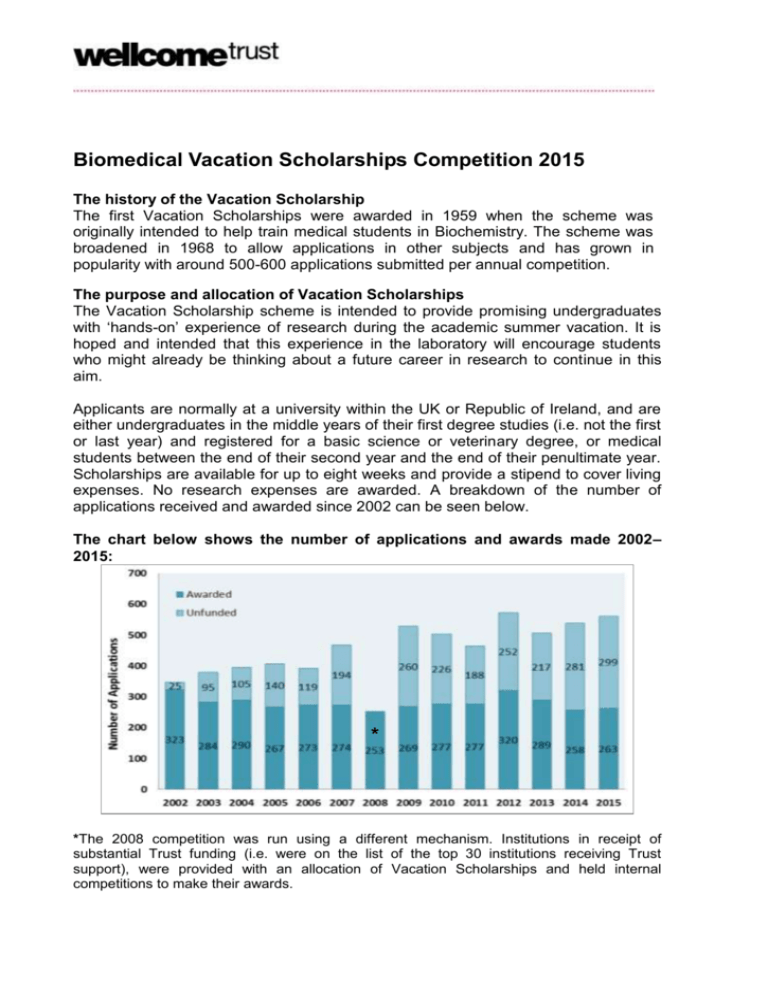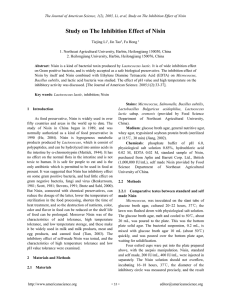report
advertisement

Biomedical Vacation Scholarships Competition 2015 The history of the Vacation Scholarship The first Vacation Scholarships were awarded in 1959 when the scheme was originally intended to help train medical students in Biochemistry. The scheme was broadened in 1968 to allow applications in other subjects and has grown in popularity with around 500-600 applications submitted per annual competition. The purpose and allocation of Vacation Scholarships The Vacation Scholarship scheme is intended to provide promising undergraduates with ‘hands-on’ experience of research during the academic summer vacation. It is hoped and intended that this experience in the laboratory will encourage students who might already be thinking about a future career in research to continue in this aim. Applicants are normally at a university within the UK or Republic of Ireland, and are either undergraduates in the middle years of their first degree studies (i.e. not the first or last year) and registered for a basic science or veterinary degree, or medical students between the end of their second year and the end of their penultimate year. Scholarships are available for up to eight weeks and provide a stipend to cover living expenses. No research expenses are awarded. A breakdown of the number of applications received and awarded since 2002 can be seen below. The chart below shows the number of applications and awards made 2002– 2015: * *The 2008 competition was run using a different mechanism. Institutions in receipt of substantial Trust funding (i.e. were on the list of the top 30 institutions receiving Trust support), were provided with an allocation of Vacation Scholarships and held internal competitions to make their awards. Breakdown 2015 Competition Analysis of the 2015 applications and the action taken towards them is as follows: Withdrawn by applicant Applications received by subject area Applications fall into one of five areas of biomedical research: Genetics and Molecular Sciences – includes molecular and cellular biology, and chemistry, genetics and genetic mechanisms, genomics, biochemistry, bioinformatics and structural biology. Neuroscience and Mental Health – encompasses all disciplines dealing with the nervous system and its various disorders. This can span from the study of chemical mechanisms in the brain to behavioural research. This includes the areas of molecular and cellular neuroscience and cognitive and higher systems. Cellular, Developmental and Physiological Sciences – includes molecular, cellular and developmental biology, as well as research relevant to the understanding of biological processes at the cellular, organ, system and whole-animal level in health and disease. Applications received in physiology and pharmacology include basic cellular and molecular studies, whole organ, animal and clinical trials, mathematical biology, integrative physiology and toxicology. Infection and Immuno-Biology – comprises fundamental and applied research into immunology and infectious diseases of humans and animals. This includes field research, epidemiological research, clinical research, molecular and cellular immunology, vector biology and vaccine and drug development. Population Health – research to improve our understanding of the determinants of disease and quality of life in populations, and to provide evidence to inform decisions in public health and healthcare delivery. Promoting translation into policy and practice, and fostering disease prevention approaches are other important aims. 2014 applications received by subject area 2014 application results by subject area Examples of project/student outcomes from Vacation Scholarships 2014 Project title: Student: Supervisor: Address: Haptic Enhancement of Learning Processes (HELP): Developing robotic devices with a view to helping children with neurodevelopmental disorders Imogen Crook Professor Mark Mon-Williams School of Psychology, University of Leeds Accelerating motor learning is an important area of research due to the prevalence of children in the UK with Developmental Coordination Disorder (DCD). We compared the utility of two force field systems in a motor task in enhancing learning rates of a motor task; one providing assistive forces and one augmenting errors. These results show that enhancing error produces the fastest rate of learning, whereas providing assistive forces increased error and decreased the learning rate. This suggests that error enhancement could accelerate motor learning in children with DCD and could be used as a potential intervention. Project title: Student: Supervisor: Address: Targeting angiogenic signalling for repair of peripheral vascular disease Samuel Johnson Professor M Yvonne Alexander Liverpool John Moores University 30% of patients with peripheral vascular disease (PVD) appear to have a disease in their lower limbs where oxygen cannot deliver the nutrients to the leg muscle and the leg can often become gangrenous and die. This disease is known as critical limb ischaemia (CLI) and it is unsuitable for surgical correction and patients often will undergo leg amputation within a year of seeing the doctor. Plasmids are small pieces of DNA that can be made in the lab to deliver genes that might correct this disease and reduce some of the suffering of patients with CLI. This study aimed to generate some of these corrective plasmids and to test their efficiency in cells in the lab, so that they can be tested in animal models and ultimately used in future clinical trials to enhance the quality of life in this group of patients. Project title: Student: Supervisor: Address: Characterisation of bioenergetics signature during activation of CD4+ Tlymphocytes Silvia Panetti Dr Nigel Francis College of Medicine, Swansea University T-cells, a type of white blood cell, are primarily involved in protection against germs, whilst being tolerant of normal, healthy tissue. Vaccination has saved more lives than any other medical intervention, yet surprisingly little is known about how a “memory T-cell” that provides long-lasting protection against disease is formed from a “naïve T-cell”, which has not yet encountered a pathogen. We have investigated the mechanism that enables a T-cell to become a memory cell, using a new type of technology that enables the monitoring of metabolic pathways at the cellular level. Using this novel technology, we have started to investigate how to turn on the metabolic switch that enables T-cells to form memory. This information may enable the development of more effective vaccines, as well as further our understanding of auto-immune diseases, where the body turns against itself. We have found a significant difference in metabolic signatures between different types of Tcells, depending on whether they are naïve or memory cells. This may underpin why memory cells are able to mount a more rapid and robust response when a germ is encountered for the second time. Project title: Student: Supervisor: Address: Virus infection limits normal fibrin-dependent bronchial epithelial wound repair Chris Howell Professor Jane Shute University of Portsmouth Viral causes are implicated in almost all cases of asthma attaches. The aim of this research project was to investigate the potential that a virus, in a model of viral infection of cells in the airway, would inhibit the process of repair of the lining of the lungs. Human lung epithelial cells were grown into a continuous layer using cell culture techniques, and were then mechanically wounded, treated with a synthetic virus, and observed under a video microscope for 24 hours. The videos of the cells were analysed to determine the rate of repair and time to heal in each experiment. After the cells had been allowed to repair, the solution the cells were growing in was removed and analysed to determine some of proteins the cells had released, and the enzymes produced when the cells were wounded, and in what quantities. Viral infections were found to have a significant effect, reducing the rate of repair of the wounds and increasing the time to heal. Tests using a specific enzyme (called MMP13) inhibitor showed that the effect of the virus could be neutralised by the inhibitor, indicating a way to limit the damaging effects of the virus. Project title: Student: Supervisor: Address: Molecular simulations of bacterial pore formation by antibiotic peptides Sarah Roberts Professor Jonathan Hirst University of Nottingham Lipid-II is found in bacterial cell membranes and is involved in the synthesis of bacterial cell walls. It has been shown that Lanthionine antibiotics such as nisin bind to lipid-II and disrupt the production of the cell wall. Nisin is highly effective against gran positive bacteria, hence it is important the mechanism of both nisin and lipid-II is understood to develop these antibiotics further. We set out to investigate the conformation of the lipid-II isoprenyl chain without the binding of nisin through molecular simulations at a constant room temperature of 300K. We looked at the radial distribution function of the chain end with respect to the phosphate head of the lipid-II in a bilayer and saw how this radial distribution function changed with bilayer width. Bilayer width was altered by changing the type of lipid used to build the membrane. Unsaturated lipids were also used to see if unsaturated lipids affected the chain conformation. We found that there was a correlation and that the chain had 3 specific conformations depending on bilayer width. Project title: Student: Supervisor: Address: Localising PEG-PCL polymersomes in histological preparations of bone postfracture Alethia Hoad Dr Tracey Newman Medicine, University of Southampton In the UK, 38% of the population will fracture a bone each year. 5-10% of those cases result in a non-union, where there is delayed or lack of healing. At present, the treatment for a nonunion is surgery, which costs the NHS between £7,000 - £79,000 per case and has a significant impact upon the patients’ quality of life and economic status, Currently there is no medication that can promote bone regeneration without causing serious side effects, however, the use of nanaoparticles may offer a new avenue to treat due to their ability to deliver a drug to a specific site within a measurable time-frame. This research project looked into the effectiveness of PEG-PCL polymersomes, a type of nanoparticae, at delivering a regenerative drug to a fracture site. We loaded polymersomes with a florescent dye to represent the drug and identify their location. Then using samples from a mouse model of bone injury, we calculated the amount of florescent dye present within the bone tissue at the site of injury in comparison to a non-injured bone tissue sample. The results show that the dye was present at the site to the fracture, implying that the nanoparticles are capable of delivering a drug to their target location. Project title: Student: Supervisor: Address: Exploring the heritability of chronic fatigue syndrome Katherine Ann Seton Professor Julia L Newton Institute of Cellular Medicine, Newcastle University The prevalence of chronic fatigue syndrome (CFS) is estimated to be 0.19% in the UK according to Nacul et al (2011). CFS was described by the Centers for Disease Control and Prevention as a sudden onset of fatigue lasting 6 months or more in adults accompanied by at least four other symptoms. The cause of CFS is unknown. CFS can be seen to follow a viral or bacterial infection. Additionally, twin and familial studies suggest a heritable component to CFS. Questionnaires were answered by 74 subjects with formal and nonformal diagnoses of CFS. They were used to establish the percentage of parents, siblings and offspring affected by CFS, and how their diagnoses were made. A formal diagnosis was given to those with a diagnosis made at a specialist clinic. A non-formal diagnosis was given to those who had a diagnosis given at a non-specialist health service (general practitioner or hospital clinic) and those with a self-reported diagnosis. 3% of the 338 relatives (parents, siblings and offspring) had a formal diagnosis, which is higher than the UK population prevalence of 0.19%. This implies CFS is more common in families, and therefore has a heritable component. Project title: Student: Supervisor: Address: Understanding the link between metabolic characteristics and depressive symptoms Andy Li Dr Silvia Liverani College of Engineering, Design and Physical Science, Brunel University The metabolic syndrome is a cluster of cardiometabolic risk factors (abdominal obesity, raised triglycerides, reduced high-density lipoprotein cholesterol, raised blood pressure and raised fasting plasma glucose) shown to be associated with depression. Standard multivariate regression techniques often do not account for collinearity issues between the metabolic characteristics profile, so we adopt profile regression techniques instead. Data used in our study is extracted from Wave 2 (June 2004 – July 2005) of the English Longitudinal Study of Aging (ELSA). Initial analysis was completed in the Statistical Package for the Social Sciences (SPSS), whilst the integral profile regression method was implemented using the PreMiuM package in R. We originally controlled for age, gender, physical activity and cases of arthritis, asthma, cancer, cardiovascular-related diseases and smoking, but out model was simplified in such a way that no significant relationship between our covariates and risk variable (depressive symptoms) could be obtained. By including our control variables as additional covariates, we have identified how our response variable (risk of depressive symptoms) can be strongly explained by sex, asthma, arthritis and cancer, which could be the cause of why we obtained the results we did in our original model. Project title: Student: Supervisor: Address: An injectable collagen hydrogel for the delivery of primary dopaminergic neurons into the Parkinsonian brain Robert F Hillary Dr Eilís Dowd Pharmacology and Therapeutics, National University of Ireland, Galway Parkinson’s disease involves the loss of a specific population of neurons, nigostriatal dopaminergic neurons, in the brain. Current therapies do not halt or reverse the progression of the disease. Primary dopaminergic neurons, derived from foetal ventral mesencephalon tissue, have been investigated for decades to regenerate the lost or damaged nigostriatal neurons in the Parkinsonian brain. However, these primary dopaminergic neurons are limited by poor graft survival (~5% of cells surviving the transplantation procedure). Therefore, the aim of this project was to assess if a biomaterial, a hydrogel composed of cross-linked collagen, supported cell viability (using mesenchymal stem cells) both in vitro and in vivo. Collagen hydrogels formulated with three different concentrations of cross-linker (6,12 and 24mg/ml) were selected for this study. It was shown that the hydrogels supported cell viability in vitro but elicited tissue damage with a subsequent host immune response upon transplantation to the brains of the relevant animal model. It is thought that this resulted from rapid gelation of the hydrogels in vivo due to the high concentrations of cross-linker. Therefore, the hydrogels fabricated with lower levels of the cross-lining agent could be investigated to determine if they could improve the outcome of such reparative cell therapies in Parkinson’s disease. Project title: Student: Supervisor: Address: The effects of dim light at night on ageing mice Ana-Maria Rotaru Professor Stephany Biello School of Psychology, University of Glasgow Dim light at night (dLAN) can affect metabolism and body mass, circadian rhythms, the immune system and behaviour. In particular, disrupted mice had been observed to gain weight despite no difference in reduced total food intake. The current study has replicated those findings and showed that ageing mice gained more weight when subjected to dLAN. The weight gain could not be explained by total activity counts or total food intake (which did not differ significantly between the control and experimental groups). This suggests that the timing of food intake, as well as the activity patterns may seriously affect metabolism. Furthermore, the disrupted sleep-wake patterns in the experimental group demonstrated how even low amounts of light can have marked effects on several physiological functions and behaviours. These findings have implications on daily human life as our world is artificially illuminated at all times. Constant light is believed to be one of the underlying factors of obesity and metabolic disorders. It can particularly affect the sleep of older individuals who already have a fragmented sleep – dLAN only intensifies this disruption. Lastly, our society highly depends on shift workers who may be suffering from chronic sleep disruption, which in turn can affect their psychological and physiological wellbeing. Project title: Identifying the role of wildlife reservoirs in the transmission of schistosoma and leishmania: major public health burdens in Brazil Bethan Kate Davies Student: Supervisor: Dr Orin Courtenay University of Warwick Address: Neglected Tropical Diseases (NTDs) are medically important infections caused by several pathogens and are prevalent in developing and low-income countries. Predominant examples in Brazil include: Schistosomiasis (caused by Schistosoma mansoni helminths) and Leishmaniasis (Leishmania braziliensis protozoa). Although these pathogens are transmitted by water-snails (e.g. Nectomys squamipes) act as alternative hosts for completion of these parasitic lifecycles. However, whether water-rodents maintain transmission cycles in the absence of human infection is unknown. Infection courses of these pathogens in naturally infected rodent populations from Amaraji, in North-East Brazil were characterised using longitudinal data and PCR reactions on rodent skin DNA samples. All S. mansoni results were negative, whereas 100% viable skin samples were positive for L. braziliensis. Results were confirmed by sequencing. Longitudinal data demonstrated a decreased rodent-L. braziliensis infectiousness through time, following removal from natural exposure, suggesting continuous natural exposure maintains infective burdens. Therefore, vector interventions for decreased exposure could lead to decreased transmission potentials. This study reinforces that targeting rodents is worthwhile to control human Leishmaniasis and, indirectly, Schistosomasis infections.










![Functionalization of Surfaces with Nisin in a Poly[ethylene oxide] brush layer](http://s2.studylib.net/store/data/015050691_1-af2ae71c944d22e8d2e8cad59c94bcc9-300x300.png)
